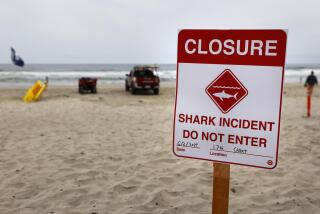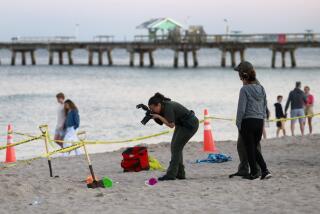Look Before You Dive, Lawyer Specializing in Paralysis Cases Warns
Former major league baseball pitcher Pete Redfern remembers with chilling clarity the day he became one of the more than 1,000 Americans paralyzed each year in diving accidents.
“I stepped up to the sea wall, and the water looked to be about five feet deep, maybe four feet deep,” Redfern said, recalling that day in Newport Beach in 1983 when he became a paraplegic, abruptly ending his career and changing his life forever.
“As I got right above the water, I looked as I pushed out off the wall and dove out further. The water had gotten shallower and I just kind of buckled up and put my knees down and tried to stop myself.
“When I hit the water, the impact caused me to go forward, and I hit my head and broke my neck. All I remember after that is a lot of pain.”
Awareness Urged
Diving accidents are the fourth-highest cause of paralysis--behind bullet wounds, traffic accidents and falls--and the overwhelming majority occur during the summer.
With the beach and pool season approaching, Jeffrey Pop, an attorney who has seen their debilitating effects, is preaching public awareness.
After all, he said, the profile of a person who is likely to be paralyzed in a diving accident is someone who was “not aware he could break his neck by diving or become permanently injured.” The Beverly Hills attorney has spent eight years specializing in representing victims of diving accidents and doing extensive research.
“The profile of the typical victim is a male, 18 to 31 years old, close to 6 feet tall, 175 pounds,” Pop said. “He will not be intoxicated, although in 40% of the cases he will have had some beer.
“He will have little or no formal training in diving. And if the accident occurs in a pool, it would have been the first time he visited that particular pool. He will not have been verbally warned and there will have been no warning signs in place.”
Swimming Pool Perils
Eighty-five percent of such accidents occur in swimming pools, and Southern California accounts for about 11% of the estimated 6 million pools in the United States.
Because the overwhelming majority of victims are injured when they dive into less than five feet of water, Pop said, it is imperative that divers be aware of a pool’s configuration.
Too many pools do not have depth markers or are inadequately marked, and others are dangerously designed, so the onus is on the diver, Pop said.
“People don’t understand the risks or they don’t take the risks seriously,” he said. “They think the worst they’ll do is break a shoulder or an arm.”
Every year regional hospitals in the United States treat more than 1,000 people paralyzed in diving accidents, Pop said, and the actual number of such cases is probably twice as high because victims treated at private hospitals are not tabulated.
One of the reasons for the high incidence of such diving accidents “is that we teach children to dive when they’re small” without telling them that the depth of water that is safe to jump into increases as they grow in weight.
Few children below the age of 12 are paralyzed in diving accidents because their low body weight acts as a cushion, he said. The same kind of dive someone easily accomplished in their formative years can, however, have tragic consequences for an adult.
A person paralyzed in a diving accident, Pop warned, faces a life confined to wheelchair, bladder problems, sexual impotence and more than $1 million in medical expenses.
More to Read
Sign up for Essential California
The most important California stories and recommendations in your inbox every morning.
You may occasionally receive promotional content from the Los Angeles Times.










